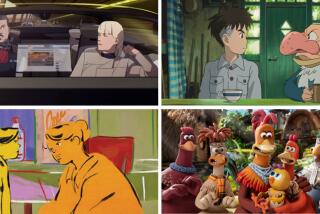Love of toys led Stéphane Aubier, Vincent Patar to ‘A Town Called Panic’
- Share via
Growing up in Belgium, the animating duo of Stéphane Aubier and Vincent Patar loved to play with plastic toy figurines.
“I had a neighbor who I was kind of jealous of because he had more,” said Aubier on the phone from New York, speaking through a translator.“I used to play with his toys.” And Patar? “I preferred to play with Smurfs,” he said.
Their love of these little plastic toys has come in handy in their adult lives. The team, known as Pic Pic André after the central characters of their first successful hand-drawn cartoon, used these playthings as the lead characters of their popular cult animated TV series, “A Town Called Panic,” which was released in several countries including the U.S. by Aardman Animations, of “Wallace & Gromit” renown.
And now they have expanded the series into a 75-minute, stop-motion animated feature of the same name, which opens today at the Nuart Theatre.
The family comedy revolves around the rather improbable adventures of Cowboy, Horse and Indian, who share a house in the small village of Panic. Their neighbors are a farmer named Steven and his wife, Janine. The animators have also introduced a new character, the mare Madame Longrée, who teaches music at the local music academy, and becomes Horse’s love interest.
Decidedly low-tech compared with such sophisticated stop-motion films as “Fantastic Mr. Fox” and “Coraline,” “Panic” manages to capture the childhood fun and exuberance of playing with these generic plastic toys.
Nostalgia isn’t the only reason the duo, who met in 1986 when they were both students at Belgium’s School of Visual Arts, decided to use these toys for their series and movie.
“Another reason is economical,” says Patar, who supplies the voice of Horse. Aubier is the voice of Cowboy. “They are inexpensive and they were very easy to find,” Patar says. “We found tons of them at flea markets that were in different positions. So getting them was relatively inexpensive and then painting them all the same color, we were able to give that illusion of movement.”
Though the figures now are being made for them in every position possible, originally they Frankensteined the toys. “We would take them apart and use different parts and reconstruct them,” Aubier said. “For example, you can’t find a figurine of an Indian reading a newspaper.”
“If you recall, there is a scene with a few of the horses climbing up on the mountain,” Patar says. “They have a humanoid appearance so we had to have those made.”
Their animation style is flexible, “which gives us a lot of freedom,” Patar says. “We are able to work fast.” At least in the stop-motion universe.
With the help of two other animators, they were able to shoot 15 seconds of footage per day. (In comparison, Patar says, Aardman -- whose “method is perhaps more sophisticated” -- might only produce 1 second of film in a day.) Some 1,500 plastic toy figures were used in the movie over the course of 260 days of production.
More to Read
The biggest entertainment stories
Get our big stories about Hollywood, film, television, music, arts, culture and more right in your inbox as soon as they publish.
You may occasionally receive promotional content from the Los Angeles Times.











